Recipe, pages 90-91.
So. It’s just my luck. The week I decide to do this dish, you know what happens?
The biggest recall of tainted domestic pistachios in the country’s history. Some 2 million pounds of the damn stuff. Recalled. Dangerous.
Made me think of an old joke.
Who’s the one guy you don’t wanna see coming through your kitchen?
“Hi! The name’s Sal,” he says as he shakes your hand.
“Sal Monella!”
Okay I’ll stop now. Remind me again, never tell jokes on this blog. “Salmonella in Pistachios Spurs Recall,” as the New York Times gleefully reported. Liable to get you crapping your guts out. I learned this a day after I made the sub-recipes for Pistachio Purée and Pistachio Chips. All the time munching on ’em as I cooked.
Harrumph.
I don’t care. Because I’m fine, so far no salmonellosis.
And to the best of my knowledge, the pistachios I bought weren’t from the culprit Setton Pistachio (“A Tradition of Excellence,” says their website) in Terra Bella, California.
Let’s live dangerously, shall we?
Day One
Lavender Pudding
I used fresh lavender flowers from my garden for this, a little less than half the amount called for dried lavender flowers. And even though I used less, the pudding still turned out a bit too potent. So when plating, I tried to use smaller dabs.
I combined the water, lavender flowers, sugar, agar, citric acid and a pinch of salt in a medium saucepan and brought to a boil for a couple of minutes. Lavender’s one of my favorite herbs. I think it should be used more in cooking, but I’m afraid most Americans think of it as a scent for soaps, cleaning products and fabric softeners. Anyway, it made the kitchen smell like a lazy day in Provence.
Then blended with an immersion blender until everything was incorporated together. Although it does not say so in the book, at this point I think I’d strain through a chinois to remove the lavender particles.
Poured into a plastic container and refrigerated until set. It took a couple of hours.
After it had set up, I chopped it up, then sheared the gel to a smooth purée in the blender. Then pushed it through the chinois. It wasn’t 100% clear, there were still some lavender particles left over in it.
Then I transferred it to a pastry tube and reserved in the fridge.
Ingredients
Water
Lavender flowers, from my garden
C&H cane sugar
Agar agar
Citric acid
Diamond Crystal kosher salt
Pistachio Purée
Perhaps I should have used Iranian pistachios after all, not the Californian. From what I’ve read, it’s difficult to find the Iranian variety in the United States, due to our tough trade regulations with Iran. And there’s an import tax upwards of three hundred percent of the value of the pistachios to import Iranian pistachios. I guess I’ll go local. In the immortal (and paraphrased) words of Rear Admiral David Farragut, “Damn the torpedoes! Full speed ahead!”
Whatever kind of pistachios you get, make sure they’re shelled and unsalted. I combined the ingredients in a saucepan and brought to a boil, then reduced to a simmer for about an hour.
Simmered until the pistachios were tender, and had absorbed much of the liquid.
I transferred the pistachios to the blender, then puréed. Until it broke. Those troublesome pistachios stripped the blender blade receptacle.
Pushed the goo through a tamis to get a smoother texture, although it says to use a chinois. See my *Note below.
I transferred the purée to a plastic container and reserved in the fridge. BTW, it lasts about a week, refrigerated.
Ingredients
Shelled unsalted pistachios, from North Park Produce
Water
C&H cane sugar
Diamond Crystal kosher salt
Pistachio Chips
Now that the pistachio purée was finished, I could make some chips with it. But first to prepare some nuts for the topping. I roasted some pistachios on a sheet pan in the oven until they released some oils and aroma. Removed. Let cool.
Then chopped roughly in my mini food processor. Alternately, you could use a knife and chop, or the bottom of a skillet and roughly crush. Whatever works for you.
I got out the good ol’ dehydrator, and sprayed the tray with a little PAM®, then wiped off the excess. Then spread a thin layer of the purée on the prepared tray.
Then topped it off with the crushed nuts.
And dehydrated at 140ºF overnight. (For about 12 hours the book says, but mine was thick and took more like a day to crisp up.)
Willy found the sweet spot. By the dehydrator’s exhaust.
Ingredients
Shelled unsalted pistachios, from North Park Produce
Pistachio purée (from recipe above)
Goat Tapioca Pearls
Mise en place:
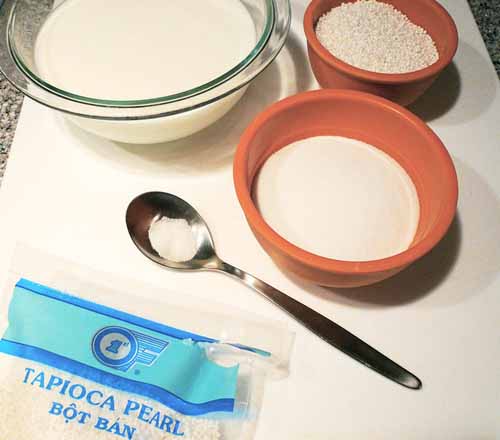
I bought pearl tapioca, or bôt bán, at my local Asian market, Vien Dong. The Vietnamese checker looked long at me, and incredulously asked if I knew how to cook them.
“Of course,” I happily replied and smiled sheepishly.
But it was plain by the look on her face she wasn’t convinced.
About Tapioca:
Tapioca is the flavorless, colorless, odorless starch extracted from the root of the cassava (Manihot esculenta) plant, also known as the cassada, manioc, mogo, mandioca or kappa. In California, we know it as the yuca or yucca. Grows all over the place. Tapioca starch is available as a powder, flakes, flour, sticks, and pearls. The pearls are made by rolling the cassava starch into balls, (available in varying sizes).
Most American kids know tapioca pearls from those little plastic JELL-O pudding cups in our school lunches. Or from home-made tapioca pudding. Asian kids love ’em in boba (or “bubble”) teas.
I soaked the tapioca pearls in goat milk overnight in the fridge. We’ll come back to that tomorrow.
Now to fix that blender…
Ingredients
Pearl tapioca, from Vien Dong
Meyenberg whole goat milk, from Whole Foods
Day Two
Goat Tapioca Pearls (Continued)
After searching through the garage for that old blender, I replaced the stripped pieces and was good to go again. Took the soaking pearls out of the fridge and strained, reserving the goat milk.
Then to cook it over a double boiler. I don’t use a fancy two-part pan system for this kinda thing. I use a saucepan and a stainless bowl (and a towel or something to guard my fingers). You don’t really need a lot of fancy equipment to cook well.

WAIT. Listen to me! Did I just say that?
Me, who just bought a dehydrator, a juicer, a Polyscience smoker, and is lusting after an anti-griddle.
Okay, never mind that last part. Cool kitchen toys are okay.
So I half-filled a medium saucepan with water and brought it to a simmer. In a stainless bowl, I combined the strained tapioca pearls, sugar, salt and a touch of the reserved goat milk. Then put it on top of the boiling pan. We’ll slow cook the tapioca so it doesn’t burn.
I cooked it until the pearls had become translucent and tender, stirring, and adding more of the goat milk as needed.
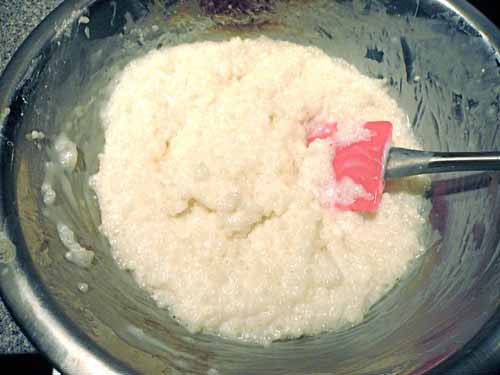
Let cool and reserved in a plastic container in the fridge. I know I must have done something correctly, as my 16 year-old son ate most of it the next morning. I say most, because as his uncle (my little brother) taught him, “Never eat the last of anything in the fridge. That way you always have plausible deniability.”
Ingredients
Reserved goat tapioca pearls
Meyenberg whole goat milk, from Whole Foods
C&H cane sugar
Diamond Crystal kosher salt
Pistachio Chips (Continued)
The pistachio purée had crisped up, so I removed it from the dehydrator tray, broke it up in smallish pieces, and reserved to an airtight plastic container.
Goat’s Milk Pudding
Mise en place:

Another pudding using Alinea’s liquid-to-solid-to-liquid technique.
I combined the goat milk, sugar, salt and agar in a small saucepan and brought to a boil — for several minutes — until the solids had dissolved. Removed from the heat and blended with my immersion blender just to make sure. Then refrigerated in a plastic container for several hours until it had set up. Took it out and chopped it up, the smaller chunks the better for blending.
You’re supposed to use a high-powered blender to shear the gel into a liquid. But I used my mini food processor to blend, as it does a better job than my bar blender. I added a bit of goat milk to loosen up the pudding as it blended.
Then you’re supposed to push the blended gel through a very fine mesh chinois. Since my blender doesn’t do so well, I forewent this and used a tamis, which has a coarser mesh than the chinois.
On a negative note though, the resulting pudding was not as smooth as I’d hoped for. A grainy mouthfeel. And it tasted slightly of agar too. Might have to adjust my amounts on that. Might also have to buck up and take the time to “do the right thing,” and use a chinois. My bad.
*Note: Chinois vs. Tamis
There are several “camps” of thought on this. Some say it’s too hard, or too much work, to pass everything through a chinois. Others say it’s not critical, use a tamis for purées and a chinois for liquids. But. if you’re going for the smoothest texture and “mouthfeel” to your foods, spend the extra time and use a chinois.
Dave Beran, Chef de Cuisine at Alinea in Chicago dictates everything should go through a chinois. “Pressing a purée through a tamis is simply lazy. It will not be smooth enough. If the purée is not going through the chinois, it is not puréed enough or too cold. A 2oz laddle will press everything through.”
Ethan Ray of The Oakroom at the Seelbach Hilton in Louisville agrees, “straining through a chinois or tami makes everything better.”
“Might as well take pleasure in it. The majority of the time there is very little glamour in working and producing food at this level. It’s really the fine details that make all the difference, and personal satisfaction of making the best product possible. (Through whatever means it takes… however long and tiring it may be.)“
In the end, the pudding was acceptable, but could have been better. Okay. Okay. I’m comin’ around to the “Keller Edict,” strain everything. Here it is in the final dish, with the tapioca pearls on top.
Ingredients
Meyenberg whole goat milk, from Whole Foods
356 Organic cane sugar, from Whole Foods
Diamond Crystal kosher salt
Agar agar
Pistachio Brittle
Mise en place:
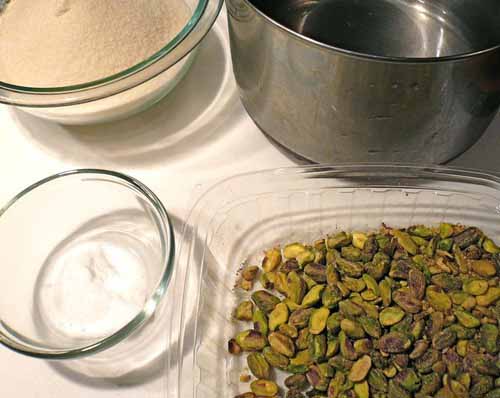
I pre-heated my oven at 350ºF, then toasted some pistachios until they released their oils and were smelly good. Removed and let cool.

Then went on to the sugar. I combined the sugar and water in a medium saucepan and brought to a boil.
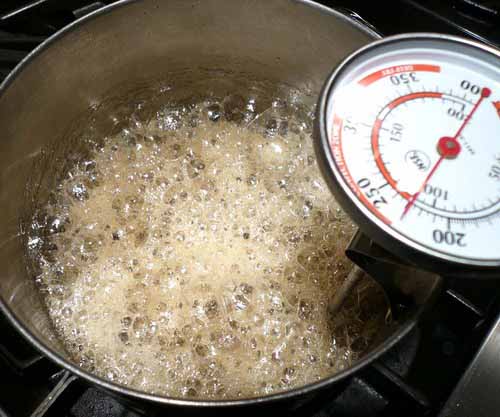
As directed in the book, I boiled the sugar until it reached 240ºF, and removed from the heat. Then added the baking soda — which makes the stuff foam up — and folded the pistachios into the mix.

Transferred to a silicone baking mat to cool.
Oops. Typo. This is what happens when you follow the recipe in the book (First edition — they have assured me that it’s being corrected in new editions), without checking the list of corrections here first.
“It was late.”
“It was the last thing I was doing that night.”
“I didn’t mean to.”
Shut up. When you’re doing a brittle, you have to cook the sugar past its hard crack stage (310ºF) to the light caramel stage (at about 342ºF), when it starts turning a caramel brown color. I should have realized what I was doing. Eeeeeck. I found more than several recipes that call for adding the nuts at 240ºF, then increasing to 340ish. Perhaps this is where that temp in the book came from?
I’m learning.
But I’m getting my ass kicked by this one.
Pretty pics. But not brittle. Damn, I believe that fresh bottle of Scottish Hendricks is calling my name.
Pg. 92, Pistachio Brittle
Change second set of temperatures from “240ºF (116ºC)” to “342ºF (172ºC)”.
Ingredients
Shelled unsalted pistachios
C&H cane sugar
Water
baking soda
Day Three
Pistachio Brittle (Redux)
Again. Shame on me. I’m not even reading my own notes and errata. So I redid the brittle recipe. Had to get more pistachios this morning. And I made sure to cook the sugar until it reached the golden brown caramel stage, 342ºF (172ºC). Added the nuts. Then added the baking soda, but not quite as much. It foamed up, and I transferred to another prepared sheet tray.
I’m determined to learn about sugars and candymaking. That, and baking, I suck at.
This time, it came out just right. Like that old peanut brittle recipe I loved as a 12 year-old kid, from the Scholastic Book Club’s Peanuts Cook Book. I broke it up into pieces and stored in an airtight plastic container.
Red Pepper Taffy
This is a really interesting recipe. And versatile too. You could use any kind of juice really.
It’s stretchy like taffy. Sweet. A beautiful color. Fun to make. And when you taste it, really good. You just can’t quite place the taste though. People are surprised when you tell them. They can’t guess.
I started with some fresh red bell peppers, seeded them and roughly chopped.
Then ran them through my juicer.
The resulting juice was BRIGHT red. A very delicious color. I strained it and reserved with the rest of the mise.
To start the taffy, I combined the bell pepper juice, sugar, isomalt, constarch, glucose, glycerine and salt in a medium saucepan.
Brought it to a boil. And kept boiling. And whisking. And boiling some more.
It took about 15 minutes or so before the sugar thickened up and reached the soft ball stage, (or 235ºF).
Then removed from the heat and stirred in the cubed butter a little at a time. The sugar went a little opaque and creamy looking. Mmmm.
I poured it out onto a sheet pan, earlier lined with a silicone baking mat. Those things are so handy. One of the kitchen toys in which you really should invest.
The cookbook says to transfer to a pastry bag and reserve at room temperature. I just put mine in a glass bowl. (I’d used the last of my pastry bags for the pistachio purée and the lavender pudding. Just thinking, would a corner-clipped freezer bag work just as well?)

Shown above, red bell pepper taffy in an alternate serving — with lavender salt-encrusted pork tenderloin, stuffed with pistachio purée.
Ingredients
Fresh red bell pepper juice
356 Organic cane sugar, from Whole Foods
Isomalt powder, from L’Epicerie
Kingsford cornstarch
Glucose (Karo light corn syrup)
NOW Foods vegetable glycerin, from Whole Foods
Diamond Crystal kosher salt
Challenge unsalted butter
Raspberry Sheet
Raspberries can be expensive. One basket at Whole Foods was US$6.99. I calculated that I’d need at least 12 for this recipe.
So I thought I’d give Specialty Produce another try. They cater to restaurants, but have a retail business as well. So I went down to their building by the railroad and trolley tracks, looking for the entrance.
A worker led me through a garage area, a walk-in refrigerator door and its plastic strips. We walked through a warehouse of meticulously organized produce, into the general holding area. Where I met several folks who explained how everything was organized. I had the run of the place. Cool.
Got a flat of fresh raspberries (12 six-ounce baskets to the flat), plenty for this dish, for about US$36.00.
I combined all but one basket of the strawberries with the sugar and water in a large pot and brought to a boil, mashing them up as I went along. The last basket of raspberries I reserved for plating.
Simmered for about 5-10 minutes until everything was wonderful.
Then strained the liquid.
I took about half and reserved. The other, I heated up again and added the gelatin, stirring until dissolved. I had previously soaked the gelatin sheet in cold water until they were pliable, squeezed out the excess water, and reserved for use now.
Then added the remainder of the juice.
I reserved the solids and cooked again, using some more water and Thomas Keller’s remouillage technique (a second, weaker stock made from the same material). No use in wasting those precious berries. Saved that strained raspberry juice for drinks.
So the last time I made a gelled sheet, I followed the Alinea instructions to a “T” and it was a time-consuming mess. Acetate. Masking tape. Squeegee-ing the sheet flat. Transferring to the freezer. Etc.
I understand the concept totally, but was unwilling to go the distance this time. I wanted to try something else.
Like Sid, “I did it my way…”
I lined a sheet tray with acetate. Sprayed it with PAM®, and wiped off the excess.
Then poured the hot raspberry gelatin onto the acetate and tilted the tray around to evenly coat. Then popped it into a level freezer.
It turned out about twice as thick as in the book. Not quite as flat or smooth. And melted at a much slower rate I’m sure. But I’m okay with that. Just look at it!
Ingredients
Fresh raspberries, from Specialty Produce
Water
356 Organic cane sugar, from Whole Foods
Rousselot “silver” gelatin sheets, from L’Epicerie
Day Four
To Assemble and Serve
Believe it or not, once you get all the component recipes completed, this is a snap to serve. And it’s a fun, hands-on dessert to have guests help with.
I got all the components out and ready to go. Also some fresh lavender flowers and leaves for garnish. Placed a couple spoonfulls of goat’s milk pudding, followed by some goat tapioca pearls, down on the square plates. Then a line of fresh raspberries and a squeeze of pistachio purée.
Had several friends over, and they wanted to join in. So they also garnished their plates with red bell pepper taffy and lavender pudding. Fun, fun, fun!
Once the basics were down, I put a raspberry sheet down over half of the components. I had previously taken the sheet pan out of the freezer and cut the large raspberry sheet down to 2-inch by 10-inch pieces. Since the sheets were a bit thick and weren’t draping over the food, I gave them a little help with a torch.
Then we finished each plate off with a few small pistachio chips, pistachio brittle chips and lavender flowers.
And served with some nice sparkling red wine.
Absolutely delicious. A unanimous decision by all.
Ingredients
Fresh raspberries, from Specialty Produce
Fresh lavender flowers, from my garden
Equipment
Salter digital scale
Measuring bowls
Kitchen knife and cutting board
Chinois
Tamis
Rubber spatulas
Glass bowl
Stainless bowls
Breville Juice Fountain Elite juicer
American Harvest Dehydrator
Cuisineart mini food processor
Cuisineart immersion blender
Medium saucepans
Candy thermometer
Wire whisks
Sheet pans
Silicone baking mats
Plastic containers
Pastry bags and tips
Plastic squeeze bottles
Kitchen blow torch
Tweezers
Serveware
Square plates, from Target
Yields: 12-16 servings, with lots of purée, brittle, and pudding left over.
Next, RASPBERRY, Goat’s Milk, Red Pepper Taffy, Pistachio (alternate serving)

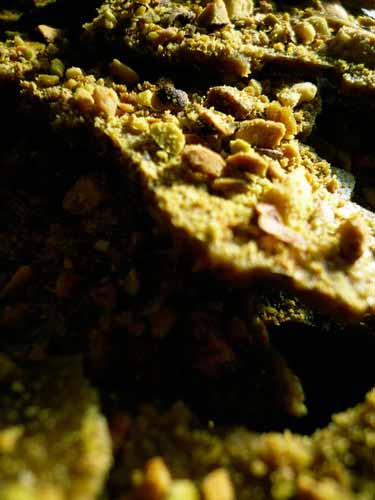
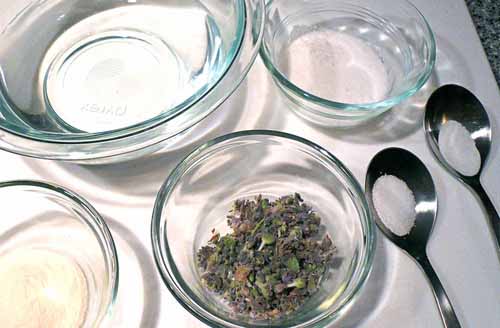

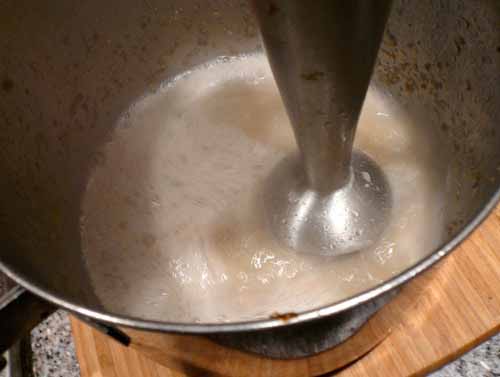
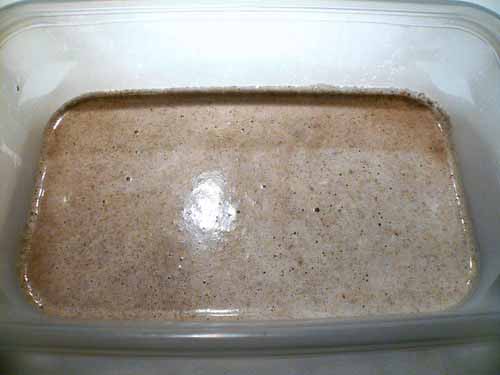
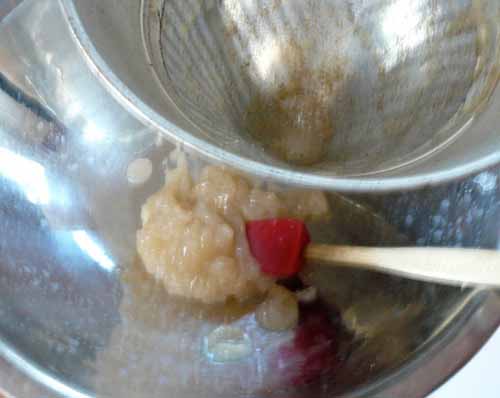

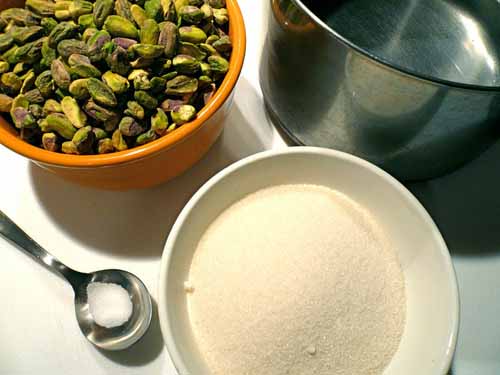
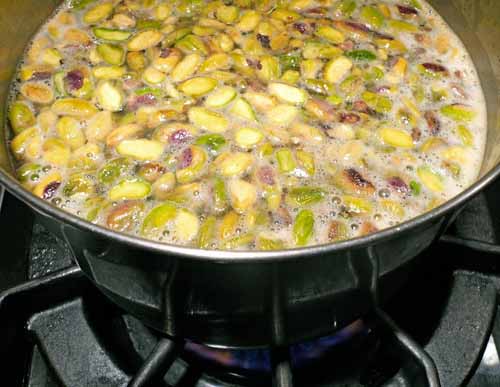

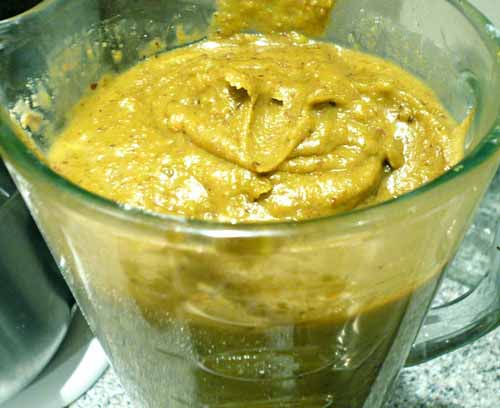

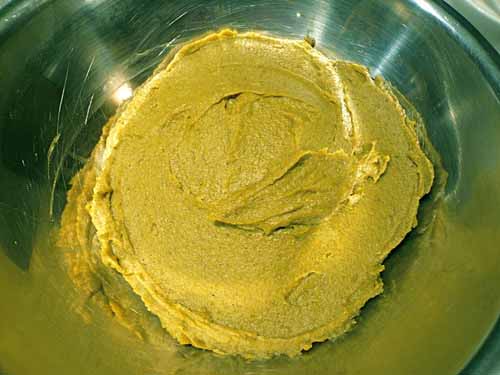
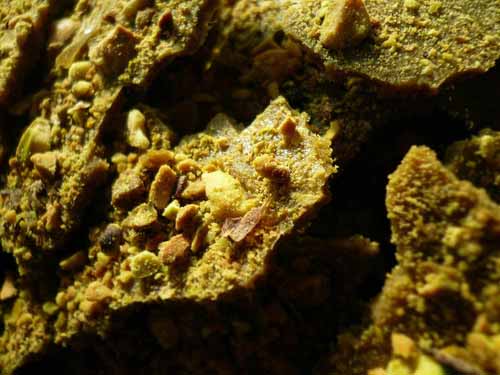


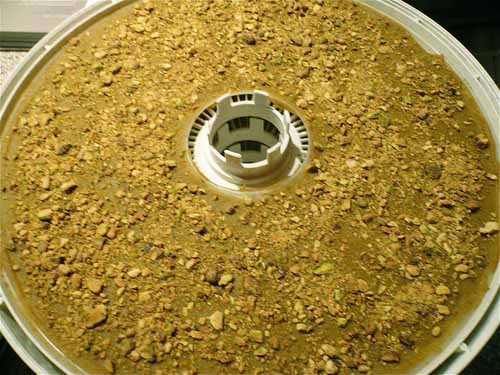
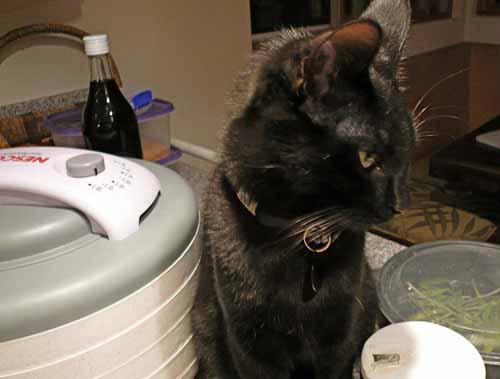


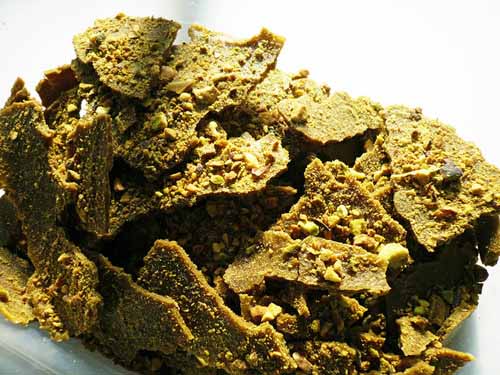
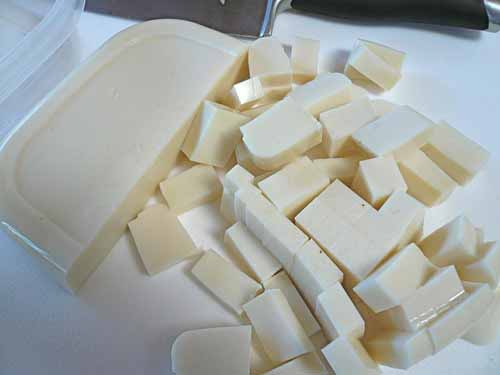
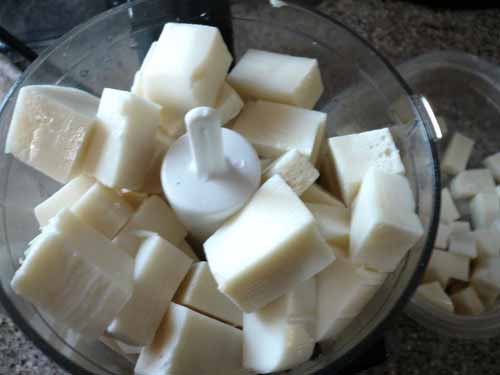
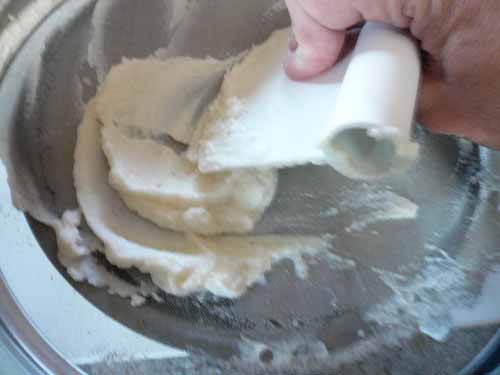
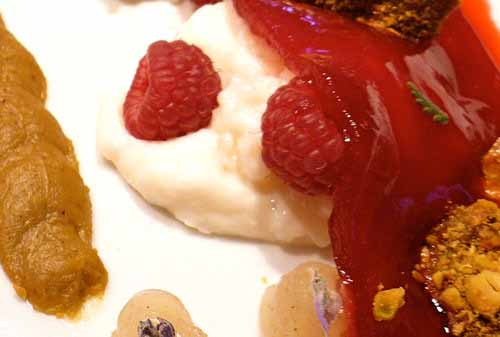
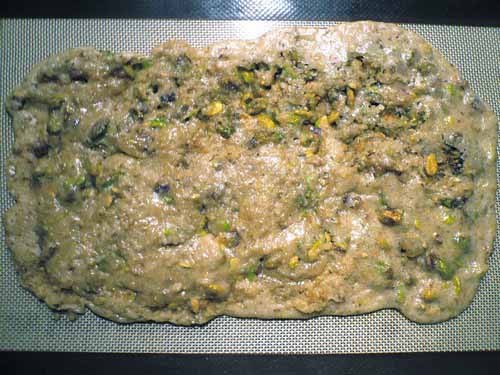
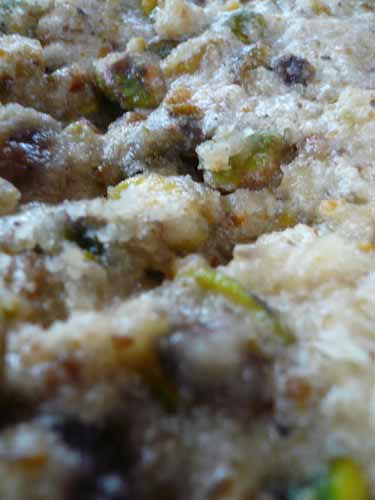

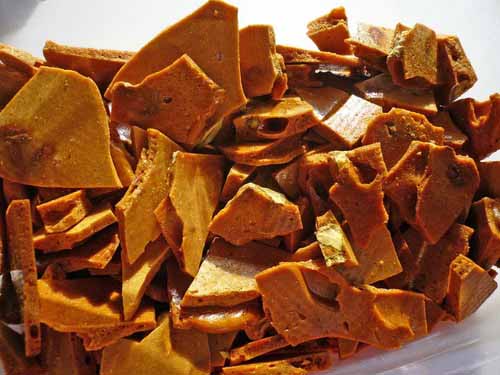
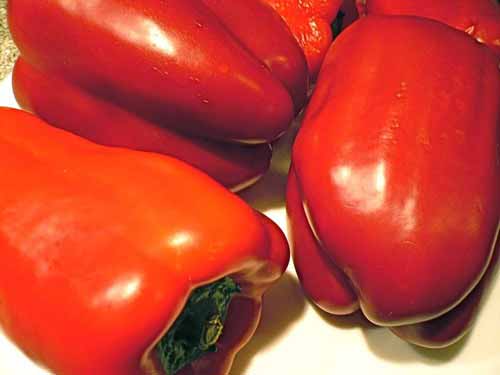

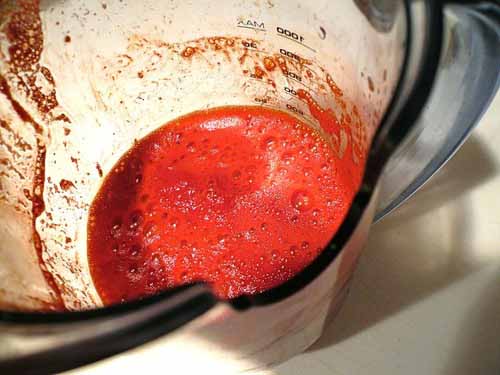

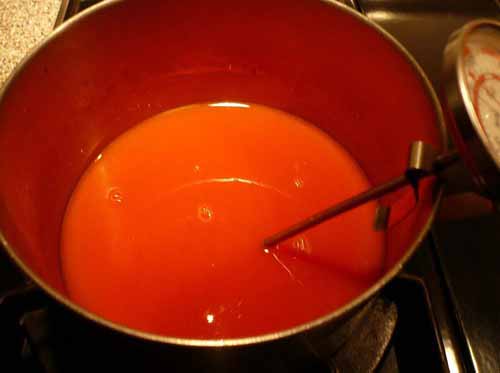
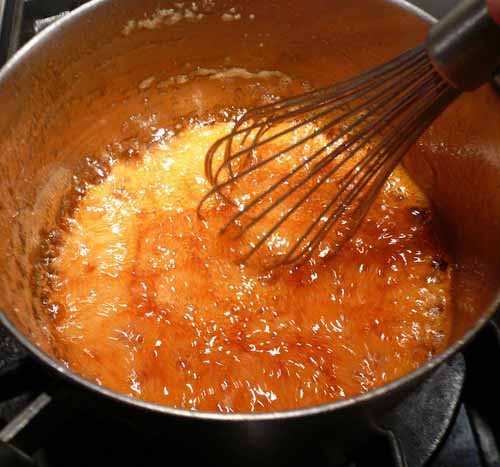
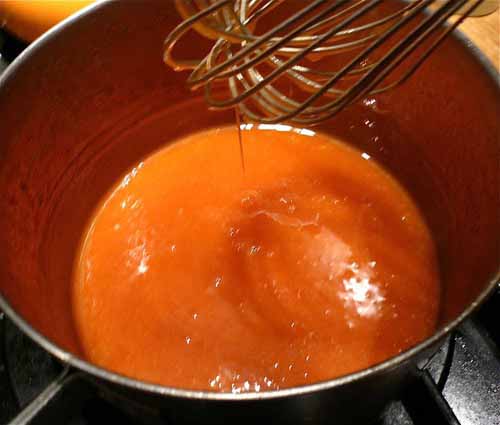
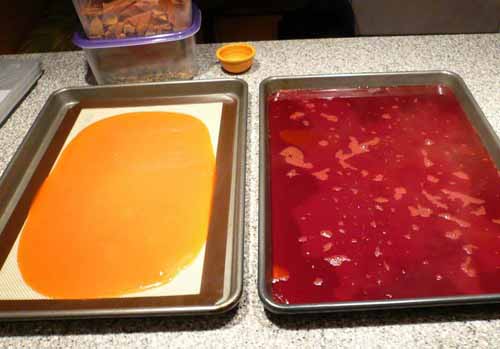

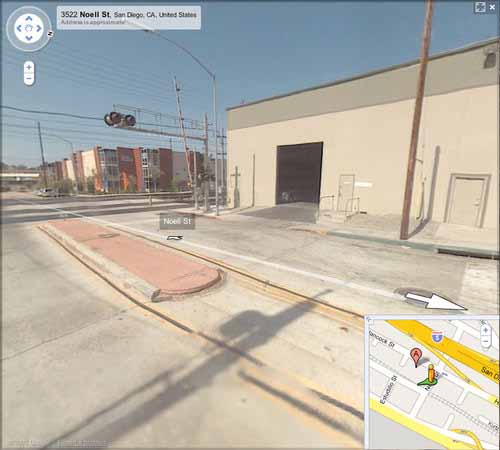


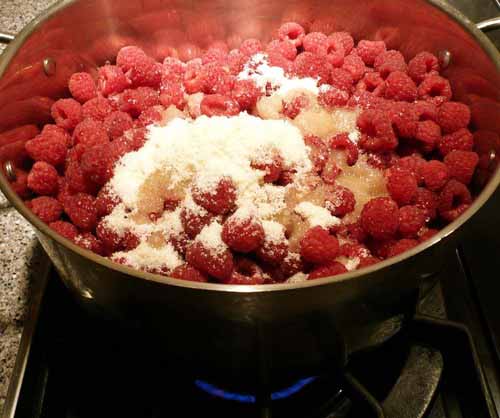
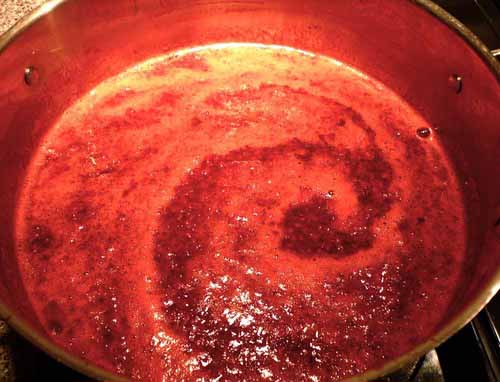

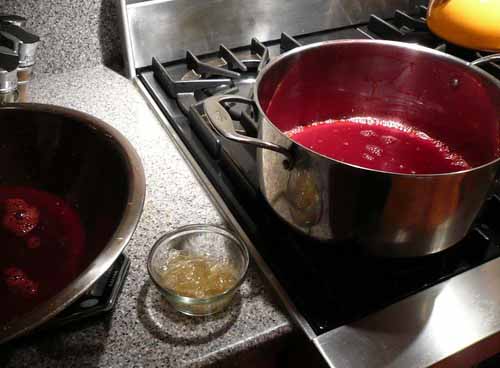
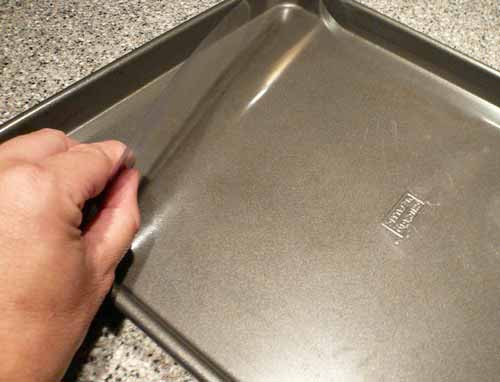

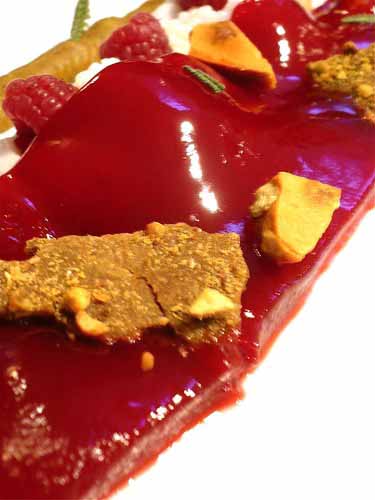


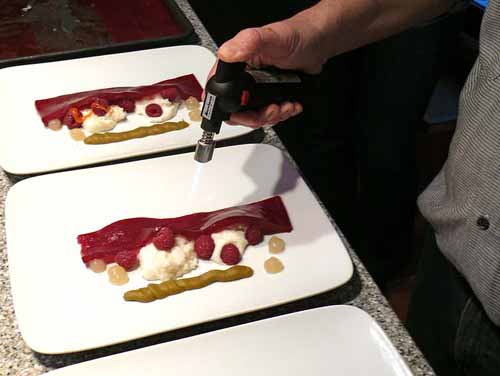


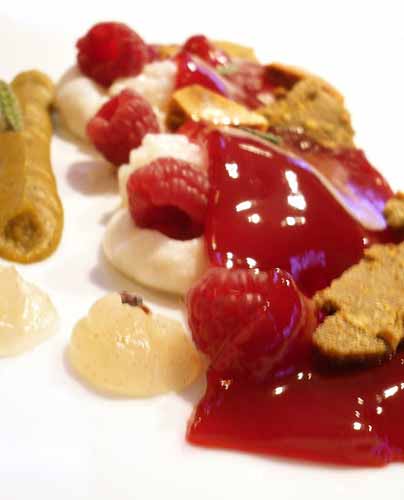
5 Responses to RASPBERRY, Goat’s Milk, Red Pepper Taffy, Pistachio